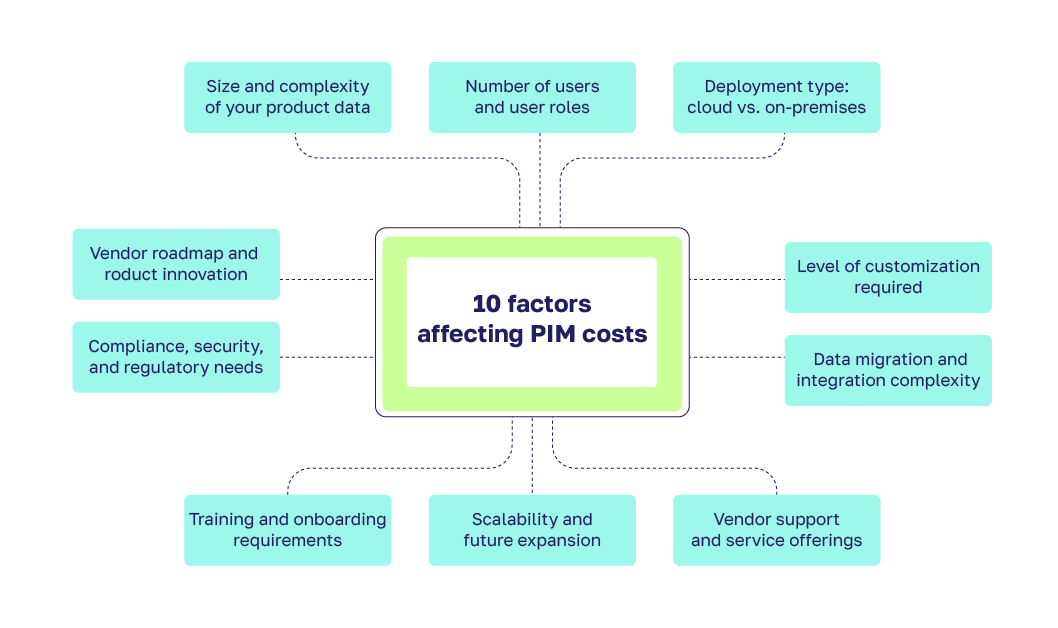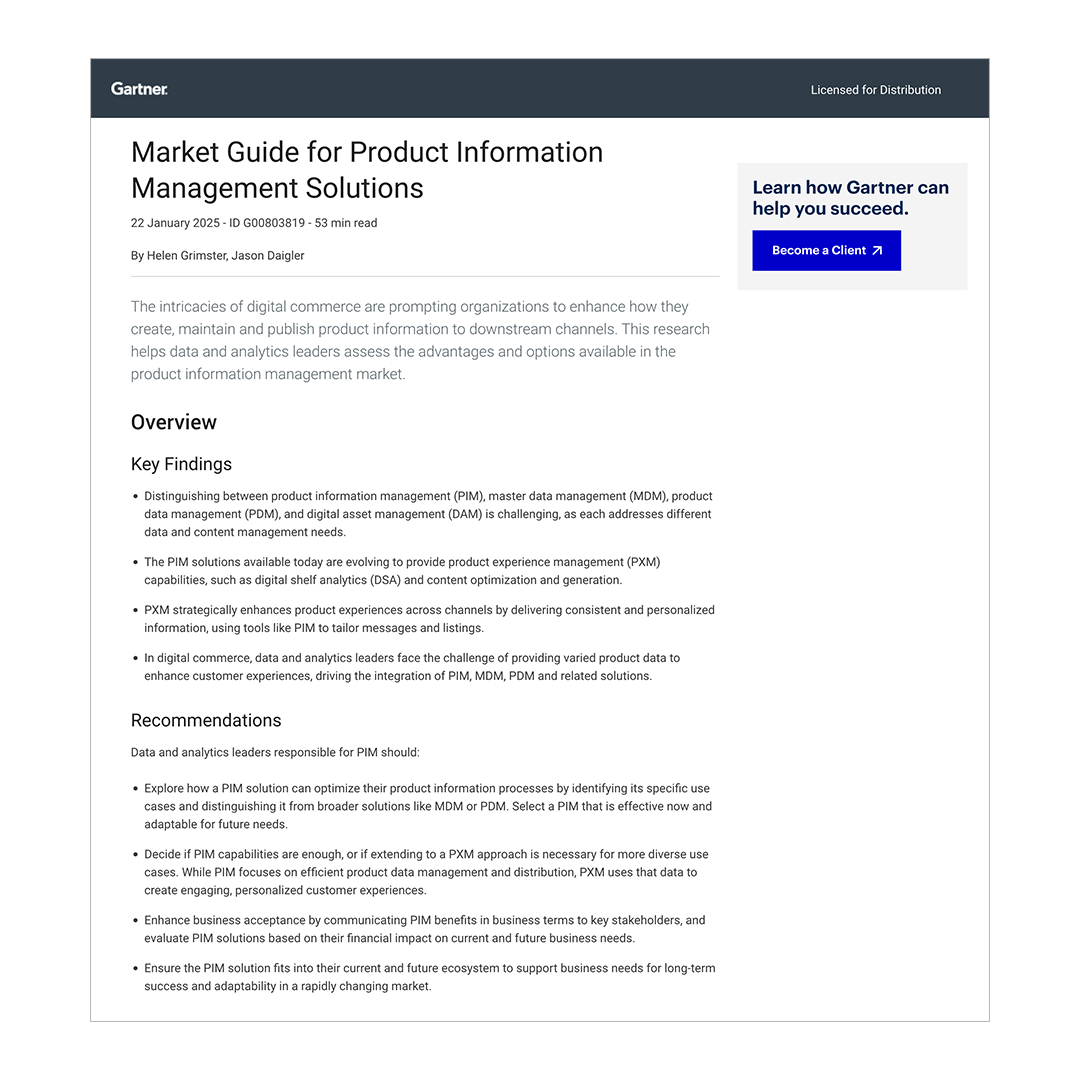10 key factors affecting the PIM cost
Choosing and implementing a PIM solution involves more than evaluating pricing tiers. Several key factors influence the cost of a PIM system, depending on the organization’s size, product complexity, and long-term requirements. Understanding these elements helps you make informed decisions and avoid unexpected additional costs.

1. Size and complexity of your product data
The volume and structure of your product data directly influence both setup and maintenance costs. A business managing a few hundred SKUs will have a vastly different implementation timeline and resource need compared to one with hundreds of thousands of products, variants, and localized attributes. Complex data models, multilingual content, and nested product relationships can increase configuration time and raise the total cost of PIM system due to more advanced requirements in modeling, validation, and governance.
2. Number of users and user roles
PIM pricing often scales based on the number of users and the complexity of role-based access. Organizations with multiple departments, such as ecommerce, marketing, product, and IT, will need more user licenses and detailed permission settings.
Planning for user provisioning early helps control licensing expenses and ensures long-term scalability without surprise fees.
3. Deployment type: cloud vs. on-premises
Your choice between a cloud-based PIM and an on-premises solution has a direct impact on both initial and long-term costs. Cloud deployments offer lower upfront costs and automatic updates, while on-premises options may involve infrastructure investments, hosting fees, and internal support resources.
However, the overall cost also depends on your organization’s IT maturity and willingness to manage ongoing maintenance internally.
4. Level of customization required
Most PIM platforms come with ready-to-use features, but tailoring the system with custom workflows, interfaces, or automation logic often demands specialized development. When aligned with true business needs, customization can boost efficiency and usability — but if not well-scoped, it can drive up both implementation costs and ongoing maintenance.
5. Data migration and integration complexity
Migrating from legacy systems or spreadsheets into a structured PIM environment is rarely straightforward. The process often involves not just moving data, but cleaning it, standardizing formats, aligning taxonomies, and resolving gaps or duplication.
If your PIM needs to integrate with ERP, ecommerce, DAM, or third-party platforms, custom connectors or middleware may be required — each adding additional costs and implementation time. Early-stage planning around integration architecture is critical to avoid delays or rework.
6. Vendor support and service offerings
Support levels vary widely between PIM providers. Some include onboarding, training, and dedicated success teams, while others offer these services à la carte. Higher-touch support can accelerate deployment and increase adoption, both of which improve ROI, but may come at a premium.
Understanding what’s included versus optional can help you accurately forecast total service-related spend.
7. Scalability and future expansion
As your product catalog grows or your sales channels diversify, your PIM needs to scale without requiring a full reimplementation. A scalable architecture supports business expansion while minimizing long-term operational costs.
Consider whether the platform can handle additional languages, data types, or channel integrations, before you outgrow your system and incur platform-switching costs.
8. Training and onboarding requirements
Successful adoption depends on well-planned onboarding. Effective user onboarding is key to long-term success, but it can introduce short-term resource strain. Some teams may require in-depth training sessions, role-specific documentation, or access to a sandbox environment for practice.
Whether handled internally or through vendor-led sessions, training time and cost should be factored into your budget from the start.
9. Compliance, security, and regulatory needs
Industries with strict regulatory or data privacy requirements must evaluate how the PIM system supports compliance. Features like audit logs, role-based permissions, and encryption may be standard or offered at an additional cost.
Beyond legal compliance, these features also play a role in securing customer trust and maintaining operational resilience.
10. Vendor roadmap and product innovation
The pace at which a PIM provider evolves its platform can significantly impact the cost over time. A vendor with a clear, forward-thinking product roadmap may reduce the need for external add-ons or costly workarounds in the future.
Prioritizing innovation also ensures the PIM system remains compatible with emerging ecommerce trends and technologies, minimizing long-term upgrade or replacement costs.
Hidden PIM costs that companies often forget about
While upfront pricing and subscription models are easy to quantify, there are often overlooked costs that can affect the overall cost of a PIM implementation. Identifying these hidden costs early helps organizations plan more accurately and avoid budget overruns.
- Internal resource allocation: Implementing a PIM solution often requires involvement from internal teams, including IT, product management, marketing, and ecommerce. The time and effort spent on data preparation, system testing, and ongoing governance represent a significant indirect cost.
- Change management: Transitioning to a new system can introduce challenges across teams. Training, adapting workflows, and ensuring user adoption require time and planning, which may not be fully captured in the initial pricing.
- Third-party services and consultants: Some organizations may rely on external consultants for implementation, integration, or training. These services can be essential for a successful rollout but are often separate from standard vendor pricing.
- System extensions and integrations: As business needs evolve, companies may need to expand their PIM with additional modules or integrations. These enhancements can introduce unplanned additional costs over time.
- Delayed time-to-value: If the system is not fully optimized or correctly aligned with business processes, it may take longer to realize expected benefits, potentially increasing the cost of purchasing a PIM system beyond initial projections.
- Lack of AI-powered features: A solution without AI-powered features may require more manual data handling, increasing time-to-value and long-term operational costs.
Tips for calculating the total cost of ownership (TCO)
To make informed decisions around pricing, it’s essential to evaluate the Total Cost of Ownership (TCO), not just the initial investment. TCO encompasses every cost associated with acquiring, implementing, and maintaining a PIM solution over its lifecycle. Taking a comprehensive approach helps you plan budgets accurately and avoid unexpected additional costs.
- Include both direct and indirect costs: Direct costs such as licensing, implementation, and training are easy to identify. Indirect costs, like internal resources, data migration, or downtime during onboarding, are often underestimated but can significantly impact the cost.
- Account for growth and scalability: Consider future requirements such as expanded product catalogs, additional users, or new channels. A scalable PIM tool that can adapt to these needs without major reconfiguration helps control long-term costs.
- Evaluate integration and maintenance needs: TCO should include the effort and expenses involved in integrating the PIM with ERP systems, ecommerce platforms, and third-party tools. Ongoing maintenance, software updates, and technical support should also be factored in.
- Assess vendor transparency:Work with a PIM provider that offers clear, upfront pricing and explains what is included (and not included) in the quoted costs. This reduces the risk of hidden fees that could increase the overall cost.
Understanding the full scope of TCO allows you to align your PIM solution investment with long-term strategic goals, ensuring both financial control and operational efficiency.
SaaS vs. on-premises – cost comparison
When evaluating the cost of a PIM system, the choice between Software-as-a-Service (SaaS) and on-premises deployment plays a significant role. Each model carries different financial implications, technical requirements, and long-term commitments. Understanding these differences is essential for aligning the PIM strategy with organizational needs and resources.
| Factor |
SaaS (Cloud PIM) |
On-Premises PIM |
| Upfront investment |
Lower upfront costs via subscription-based pricing |
Higher initial costs (licenses, hardware, IT infrastructure) |
| Maintenance and upgrades |
Managed by the PIM provider (updates, monitoring, support) |
Requires internal IT resources for ongoing maintenance and upgrades |
| Scalability and flexibility |
Easily scalable; supports quick additions of users, features, and integrations |
May require additional infrastructure for scaling |
| Security and compliance |
Offers enterprise-grade security and compliance features |
Full control over data, with responsibility for security and compliance |
| Long-term costs |
Ongoing subscription fees, but typically lower infrastructure and support costs |
Potential for lower long-term fees, but variable costs due to maintenance and scaling |
Choosing between cloud PIM and on-premises should be based on business priorities, available IT support, scalability goals, and the implementation cost structure that best fits long-term planning.
Contentserv – a smart investment for your PIM budget
Selecting a Product Information Management (PIM) solution involves balancing cost, scalability, and long-term value. Contentserv is designed to help organizations manage their product data efficiently while maximizing return on investment through a flexible and scalable platform.






